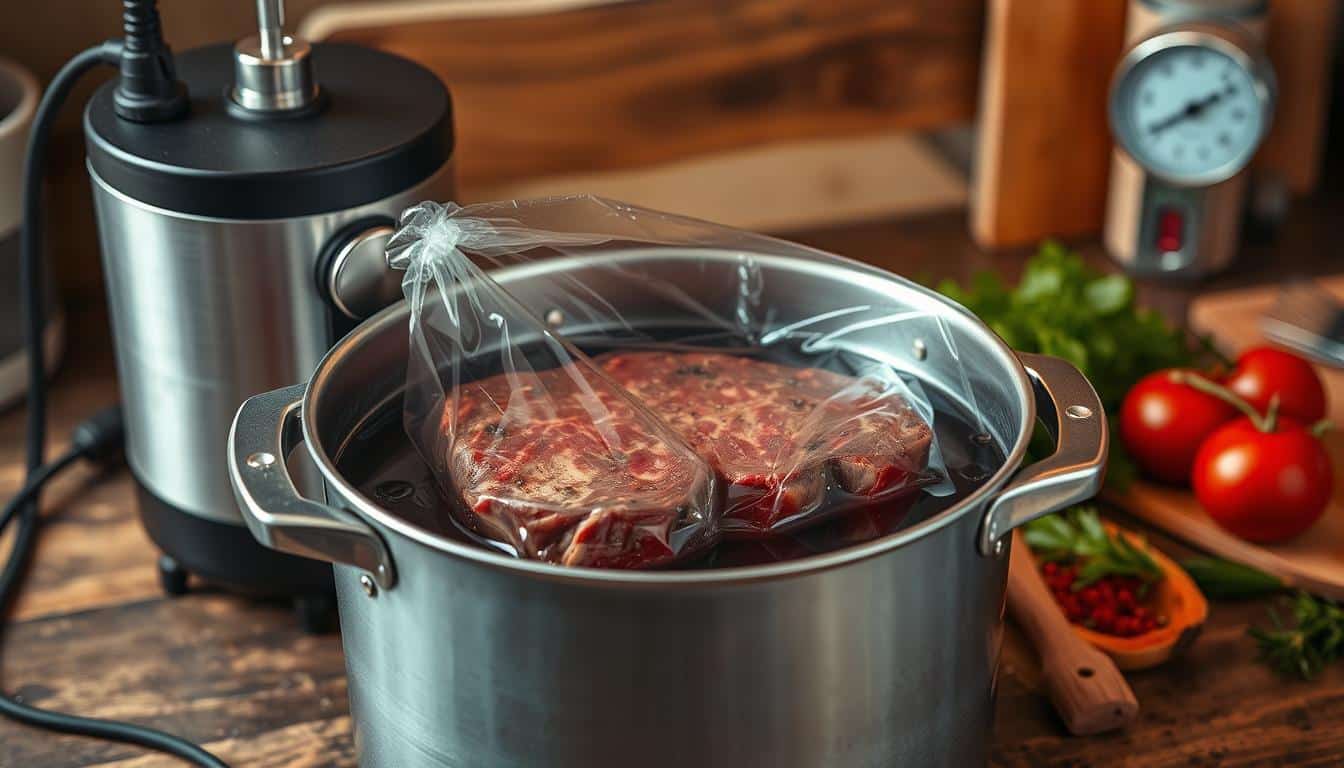Welcome to the world of sous vide steak. Here, precision cooking meets culinary excellence. We’re about to change your steak game forever. This guide will show you how to make restaurant-quality steaks at home.
Sous vide means “under vacuum” in French. It’s a cooking method that gives you total control. By using it, you’ll get steaks with amazing flavor and texture. We’ll show you how to do it, from choosing the right tools to making that perfect crust.
Get ready to learn about the science of sous vide. We’ll cover the essential tools and share pro tips for perfect steak. Whether you’re a pro chef or just starting, this guide will take your steak game to the next level.
Understanding Sous Vide Steak Fundamentals
Sous vide cooking has changed how we make steaks. It makes sure the meat is cooked just right every time. Let’s look at what makes sous vide special and why steak lovers love it.
What Makes Sous Vide Cooking Special
Sous vide is known for its exactness. Food is sealed in a bag and cooked in water at a set temperature. This method heats the steak evenly, making it tender all the way through.
The Science Behind Perfect Temperature Control
The secret to sous vide’s success is its exact temperature control. Unlike other cooking methods, sous vide keeps the temperature steady. This slow cooking breaks down proteins, making the steak juicy and tender.
Benefits of Low-Temperature Cooking
Low-temperature cooking is key in sous vide. It has many benefits:
- Enhanced flavor retention
- Improved moisture content
- Consistent doneness
- Reduced risk of overcooking
| Cooking Method | Temperature Control | Moisture Retention | Consistency |
|---|---|---|---|
| Sous Vide | Precise | High | Excellent |
| Grilling | Variable | Low | Inconsistent |
| Pan-Searing | Moderate | Moderate | Good |
Learning sous vide will help you make meat that’s tender and juicy. Your steaks will impress anyone.
Essential Equipment for Sous Vide Success
Precision cooking with sous vide steak needs the right tools. We’ll show you what you need for this foolproof method. With the right setup, you’ll make perfectly cooked steaks every time.
Choosing the Right Immersion Circulator
An immersion circulator is key for sous vide cooking. It heats and circulates water for precise temperature. Look for models with accurate temperature control and easy interfaces. Some even connect to your smartphone for remote monitoring.
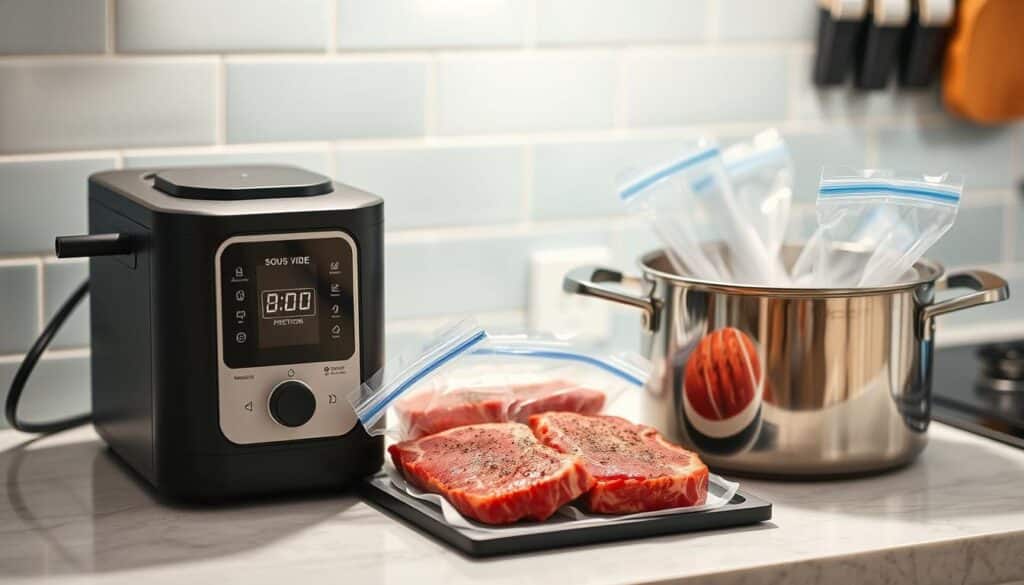
Container and Storage Solutions
A large, heat-safe container is vital for sous vide cooking. Home cooks often use large pots or plastic containers. Insulated containers keep temperatures steady for long cooks. For storage, stackable containers save space when not in use.
Vacuum Sealing vs. Water Displacement Method
Sealing your steak is a key step in sous vide cooking. Vacuum sealers create a tight seal, great for long cooks and marinating skirt steak. The water displacement method, using zipper-lock bags, is cheaper and works for shorter times.
| Method | Pros | Cons |
|---|---|---|
| Vacuum Sealing | Perfect seal, ideal for long cooks | Requires special equipment |
| Water Displacement | Cost-effective, simple | Less reliable for extended cooks |
With these tools, you’re set for your sous vide steak journey. This method ensures consistent results, turning your kitchen into a gourmet steakhouse.
Selecting the Perfect Cut for Sous Vide Steak
Choosing the right cut of beef is key for a juicy steak. We’ll show you how to pick the best cuts for sous vide. This way, you’ll get tender meat every time.
Ribeye is a top pick. Its marbling makes it rich in flavor and tender. New York strip is leaner but just as tasty.
Filet mignon is known for its buttery texture. Sous vide makes it even more luxurious. T-bone and porterhouse steaks offer two cuts in one. Flank and skirt steak are budget-friendly but become tender with sous vide.
| Cut | Flavor Profile | Best For |
|---|---|---|
| Ribeye | Rich, beefy | Indulgent dining |
| NY Strip | Balanced | Everyday gourmet |
| Filet Mignon | Subtle, refined | Special occasions |
| Flank/Skirt | Intense beef flavor | Fajitas, stir-fries |
Thickness is important in sous vide cooking. Choose cuts at least 1-inch thick. This ensures a perfect medium-rare center. Follow these tips for the best sous vide steak.
Temperature Guide for Different Levels of Doneness
Precision cooking with sous vide lets you control your steak’s doneness perfectly. Our temperature guide helps you get the perfect result every time. It’s a foolproof method.
Rare to Well-Done Temperature Charts
Low-temperature cooking is key to sous vide’s success. Here’s a chart for achieving your desired doneness:
| Doneness | Temperature (°F) | Temperature (°C) |
|---|---|---|
| Rare | 120-128°F | 49-53°C |
| Medium-Rare | 129-134°F | 54-57°C |
| Medium | 135-144°F | 57-62°C |
| Medium-Well | 145-155°F | 63-68°C |
| Well-Done | 156°F+ | 69°C+ |
Timing Guidelines for Various Cuts
Different cuts need different cooking times. For a 1-inch thick steak, plan on:
- Tender cuts (ribeye, NY strip): 1-4 hours
- Tough cuts (chuck, round): 4-10 hours
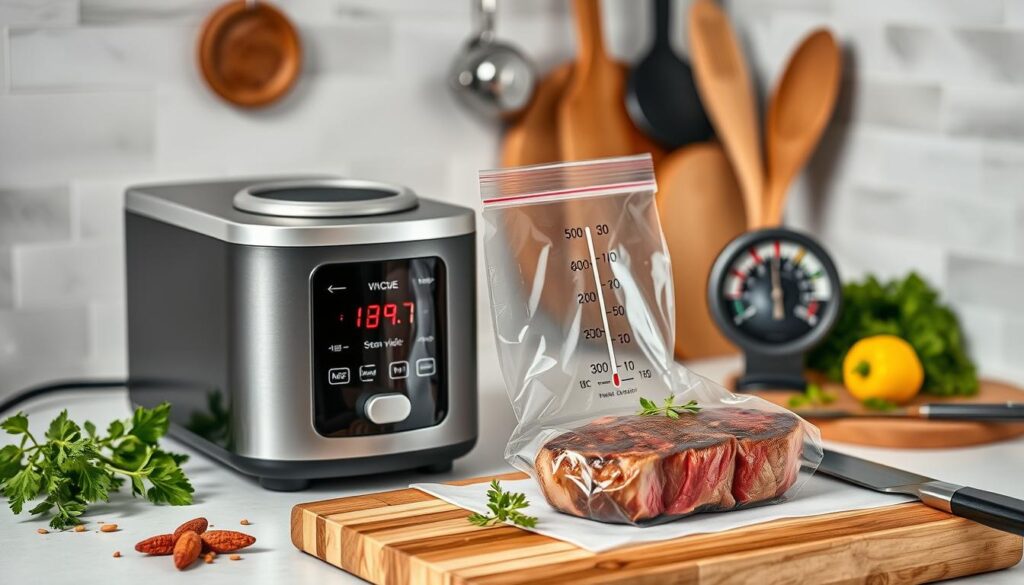
Impact of Thickness on Cooking Duration
Steak thickness affects cooking time. Add 30 minutes for each extra ½ inch. This ensures your sous vide cooking is always perfect, no matter the cut size.
Pre-Cooking Preparation and Seasoning
Getting your steak ready for sous vide cooking is important for great flavor. First, we pat the meat dry with paper towels. This helps the seasoning stick better and sear well later.
For seasoning, we keep it simple but effective. Salt and black pepper are the basics. Sprinkle them all over the steak, pressing gently to stick.
- Fresh herbs (rosemary, thyme)
- Crushed garlic cloves
- A dash of smoked paprika
For bolder tastes, a quick marinade helps. Mix olive oil, Worcestershire sauce, and herbs. Coat the steak and chill for 30 minutes before cooking.
| Seasoning | Flavor Profile | Best Paired With |
|---|---|---|
| Salt & Pepper | Classic, enhances natural beef flavor | All cuts |
| Garlic & Herbs | Aromatic, Mediterranean | Ribeye, Sirloin |
| Smoked Paprika | Smoky, slightly sweet | Strip steak |
Remember, sous vide cooking makes flavors stronger. Use your seasonings wisely. With these tips, you’re ready for a memorable steak.
Step-by-Step Sous Vide Steak Process
Learning the sous vide steak process is essential for perfect results. Our foolproof method guides you through each step. This ensures your steak is cooked to perfection.
Preparing the Water Bath
Start by filling a large container with water. Attach your immersion circulator to it. Choose the right temperature for your steak’s doneness. For medium-rare, aim for 130°F (54°C).
Wait until the water reaches the target temperature. Then, you can move on to the next step.
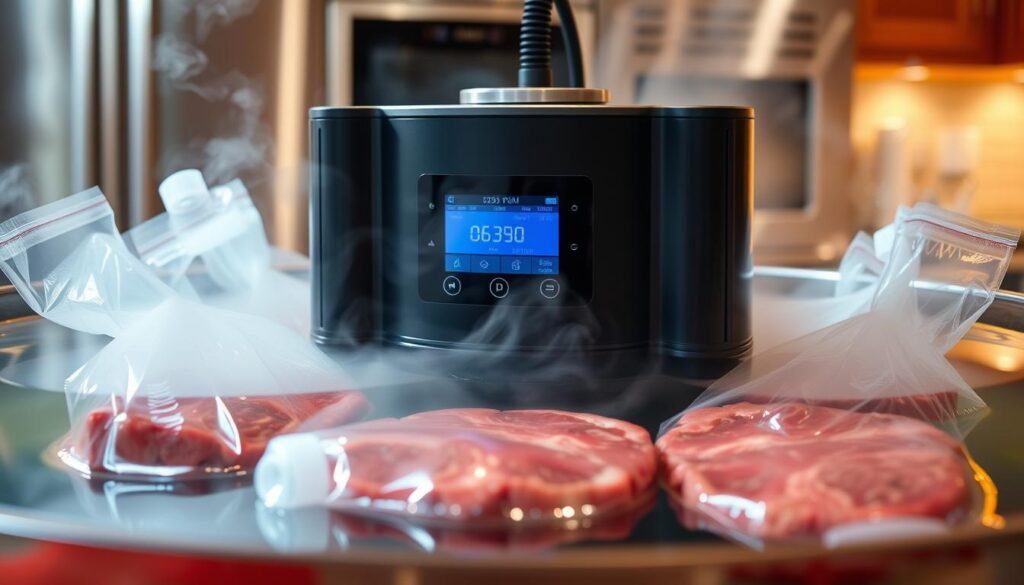
Sealing and Submersion Techniques
Season your steak with salt and pepper. Then, put it in a vacuum-sealed bag or a zip-top bag using the water displacement method. Slowly lower the bagged steak into the water.
Make sure to seal the bag before it’s fully submerged. This ensures even cooking.
Monitoring During Cooking
After submerging, let the steak cook for the right amount of time. A 1-inch thick steak needs 1-2 hours. Check the water level and temperature often.
| Steak Thickness | Cooking Time | Temperature (Medium-Rare) |
|---|---|---|
| 1 inch | 1-2 hours | 130°F (54°C) |
| 1.5 inches | 2-3 hours | 130°F (54°C) |
| 2 inches | 3-4 hours | 130°F (54°C) |
By following these steps, you’ll get a perfectly cooked sous vide steak. It will be tender and flavorful every time.
Finishing Techniques and Searing Methods
After sous vide cooking, we add a perfect sear to our steak. This step makes the flavor pop and adds texture. Let’s look at three popular ways to sear your steak.
Cast Iron Searing
Cast iron searing is a classic method. Heat your skillet until it’s very hot. Pat the steak dry, then sear for 30-60 seconds on each side. This creates a tasty crust and keeps the inside tender.
Torch Finishing
Using a culinary torch for searing is precise. It lets you focus on specific parts of the steak. Move the flame slowly to avoid burning. Torch finishing gives you full control over the searing.
Grill Searing Options
Grilling adds a smoky taste to your sous vide steak. Heat your grill to high. Sear the steak for about 1 minute on each side. This mix of sous vide and grill gives the best of both worlds.
Each searing method adds something special to your steak. Try these techniques to find your favorite way to get that perfect crust and flavor. Remember, a quick sear keeps the inside tender from sous vide cooking.
Mastering the Perfect Crust While Maintaining Tenderness
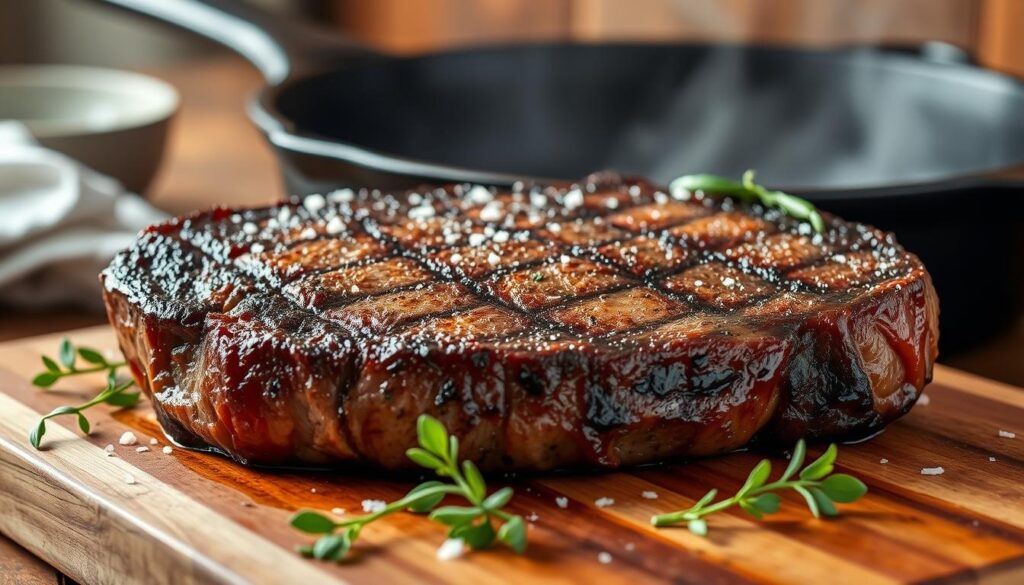
Making a tasty crust on your sous vide steak is an art. We’ve found ways to get that perfect caramelized outside without losing the tender meat inside. The secret is in using high heat for a short time.
To get the perfect crust, dry your steak after sous vide cooking. This is key for a crispy outside. Then, heat a cast-iron skillet until it’s very hot. Sear your steak for 30-60 seconds on each side. This quick sear keeps the juices in, making your steak juicy.
For an even better crust, try the reverse sear method. After sous vide, cool your steak in an ice bath. Then, sear it in a very hot pan. This method stops overcooking and makes a great crust.
| Searing Method | Pros | Cons |
|---|---|---|
| Cast Iron Pan | Even heat distribution, great crust | Requires high heat, can smoke |
| Grill | Adds smoky flavor, good for larger cuts | Less control over heat |
| Torch | Precise control, no extra pan needed | Can be time-consuming for larger steaks |
The goal is to make a delicious crust without losing the juicy inside of your sous vide steak. With practice, you’ll get the crust right and the meat tender.
Pairing and Serving Suggestions
Make your gourmet dining better with the right pairings for your sous vide steak. We’ve picked out wine, side dishes, and presentation tips to go with your dish.
Wine Pairing Recommendations
The right wine can make your steak taste even better. For a bold steak, try a full-bodied Cabernet Sauvignon or a rich Malbec. If you like something lighter, a Pinot Noir or a Syrah is good.
Side Dish Combinations
Choose sides that balance your steak’s rich taste. Roasted veggies, creamy mashed potatoes, or a crisp salad can make your meal better. For a fancy touch, try truffle-infused fries or grilled asparagus.
| Steak Cut | Wine Pairing | Side Dish |
|---|---|---|
| Ribeye | Cabernet Sauvignon | Truffle Mashed Potatoes |
| Filet Mignon | Pinot Noir | Grilled Asparagus |
| New York Strip | Malbec | Roasted Brussels Sprouts |
Presentation Tips
The look of your dish matters for a gourmet meal. Use a warm plate to keep your steak hot. Slice it against the grain for tenderness. Add fresh herbs or compound butter for style.
Learn these cooking tips to make your sous vide steak a restaurant-quality meal at home. With the right pairings and presentation, you’ll have a meal that impresses everyone.
Conclusion
Sous vide steak cooking is a game-changer for home chefs. It lets you make restaurant-quality meals at home. With the right tools and techniques, you’ll serve up perfectly cooked steaks every time.
We’ve covered everything from equipment to temperature guides. Remember, the key is in the details. Pick the best cut, season well, and nail the searing process. These steps will elevate your steak from good to gourmet dining status.
Mastering sous vide opens up a world of culinary possibilities. It’s not just about steak – this method works wonders for many dishes. So fire up that immersion circulator and start your journey into precision cooking. Your taste buds will thank you!

